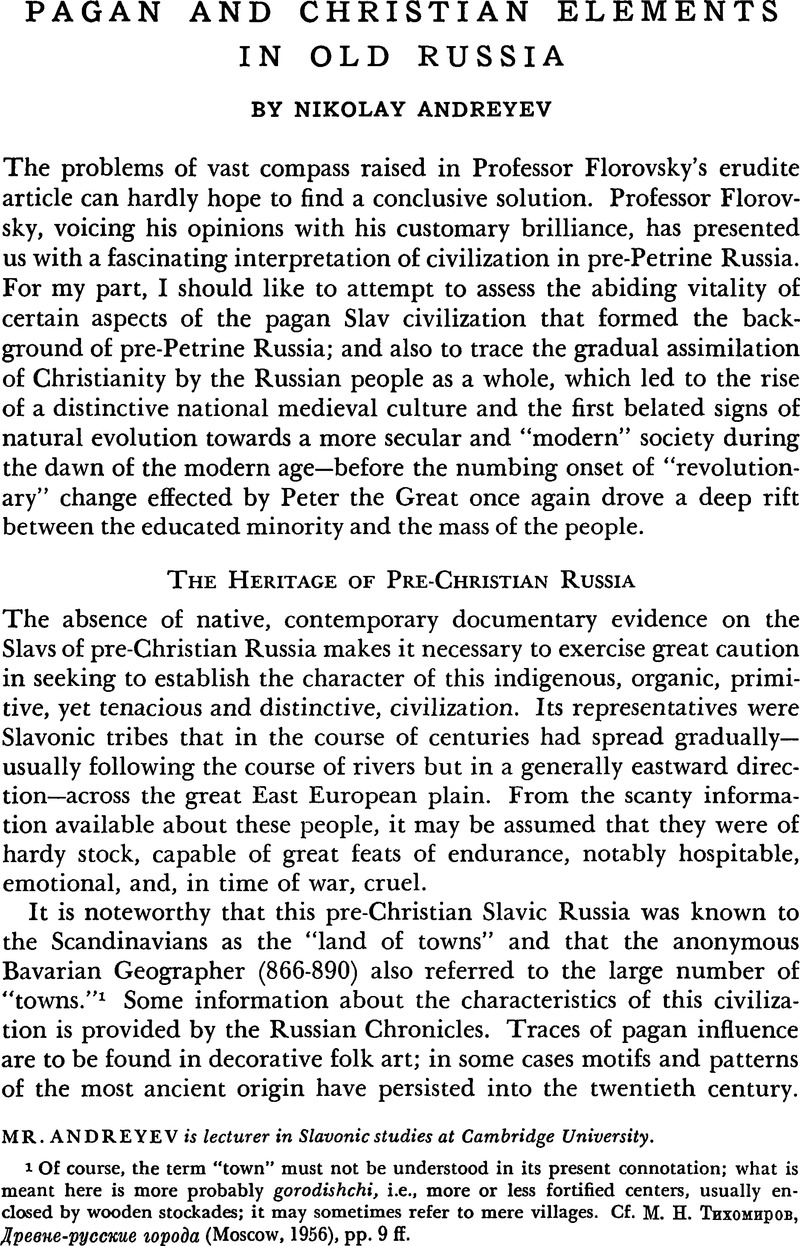Article contents
Pagan and Christian Elements in Old Russia
Published online by Cambridge University Press: 27 January 2017
Abstract

- Type
- Discussion
- Information
- Copyright
- Copyright © Association for Slavic, East European, and Eurasian Studies. 1962
References
1 Of course, the term “town” must not be understood in its present connotation; what is meant here is more probably gorodishchi, i.e., more or less fortified centers, usually enclosed by wooden stockades; it may sometimes refer to mere villages. Cf. 
2
![]() (Moscow, 1948), p. 35–119.
(Moscow, 1948), p. 35–119.
3
![]() (MOSCOW, 1952), pp. 4 ff.
(MOSCOW, 1952), pp. 4 ff.
4
![]() (Moscow, 1950), p. 297.
(Moscow, 1950), p. 297.
5
![]() (Moscow-Leningrad, 1950), p. 16.
(Moscow-Leningrad, 1950), p. 16.
6 During the author's archaeological and archaeographic expeditions to Petserimaa “in Estonia in 1937 and 1938 on behalf of the Kondakov Institute in Prague, he witnessed striking examples of the persistence of this dvoeverie in the Pskov-Petseri Monastery itself: devout local women would bring “offerings” of country produce (butter, eggs, and cream) to lay before a wooden statue of St. Nicholas the Miracle-Worker—gifts which were subsequently collected by the monks for the use of the abbot.
7
![]() , VIII (1951), 403-12, failed to understand the significance of this unique fresco and gave a wrong reading of the word
, VIII (1951), 403-12, failed to understand the significance of this unique fresco and gave a wrong reading of the word ![]() (p. 410).
(p. 410).
8 On pagan traditions in ancient Russian culture, cf. ![]() (St. Petersburg, 1914) and
(St. Petersburg, 1914) and ![]() I, II (Moscow, 1913). The best account in English is to be found in
Vernadsky's, George
Origins of Russia (Oxford: Clarendon Press, 1959, pp. 108–73
Google Scholar.
I, II (Moscow, 1913). The best account in English is to be found in
Vernadsky's, George
Origins of Russia (Oxford: Clarendon Press, 1959, pp. 108–73
Google Scholar.
9 Cf., for example, M. I. Rostovtsev, , The Origin of the Russian State on the Dnieper, in the Annual Report of the American Historical Association for 1920 (Washington, D.C., 1925).Google Scholar
10 George Vernadsky, , Kievan Russia (New Haven, 1948), p. 71.Google Scholar
11
![]() (Paris, 1931), p. 20.
(Paris, 1931), p. 20.
12
![]() , I and II (Paris, 1959). Cf. II, pp. 121-230 for Nikon's reforms.
, I and II (Paris, 1959). Cf. II, pp. 121-230 for Nikon's reforms.
13 I. Smolitsch, , Russisches Mönchtum (Würzburg, 1953)Google Scholar, cf. chapter on St. Sergius of Fedotov, Radonezh. G., A Treasury of Russian Spirituality (London, 1952), p. 50–83.Google Scholar
14
![]() (Moscow, 1959).
(Moscow, 1959).
15 George Vernadsky, , Mongols and Russia (New Haven, 1953), p. 325–30.Google Scholar
16 Some interesting and new ideas on this subject have appeared in ![]() (Moscow-Leningrad, 1955);
(Moscow-Leningrad, 1955); ![]() (Moscow-Leningrad, 1960);
(Moscow-Leningrad, 1960); ![]() (Moscow, 1958);
(Moscow, 1958); ![]() (Moscow, 1960).
(Moscow, 1960).
17 Cf. ![]() , III (Moscow, 1955) and IV (Moscow, 1959); also
G. H. Hamilton, , The Art and Architecture of Russia (London, 1954), pp. 115–43.Google Scholar
, III (Moscow, 1955) and IV (Moscow, 1959); also
G. H. Hamilton, , The Art and Architecture of Russia (London, 1954), pp. 115–43.Google Scholar
18
![]() , IV (Prague, 1933), p. 268–98.
, IV (Prague, 1933), p. 268–98.
19
![]() (Petersburg and Moscow, 1922), 1, 2.
(Petersburg and Moscow, 1922), 1, 2.
20
![]() , V (prague, 1932), 191-242; idem,
, V (prague, 1932), 191-242; idem, ![]() ibid., X (1938), chap, iv, pp. 195-98.
ibid., X (1938), chap, iv, pp. 195-98.
21 J Myslivec, , “Liturgické hymny jako nám£ty ruských ikon,” Byzantinoslavica, III, No. 2(1931).Google Scholar
22
![]() Seminarium Kondakovianum, VIII (Prague, 1936), p. 272–73.
Seminarium Kondakovianum, VIII (Prague, 1936), p. 272–73.
23 This subject is often misinterpreted. N. Andreyev, “Nikon and Awakum on Icon Painting, ” Revue des etudes slaves, XXXVIII, Mélanges Pierre Pascal (Paris, 1961), has attempted to reconstruct the true history of this ideological struggle against innovations.
24 Cf. the very important observations of ![]() (Moscow-Leningrad, 1958), pp. 7-26, 119-67. Cf. also D. Čiževskiy, History of Russian Literature (The Hague, 1960), pp. 320 ff.
(Moscow-Leningrad, 1958), pp. 7-26, 119-67. Cf. also D. Čiževskiy, History of Russian Literature (The Hague, 1960), pp. 320 ff.
- 1
- Cited by




